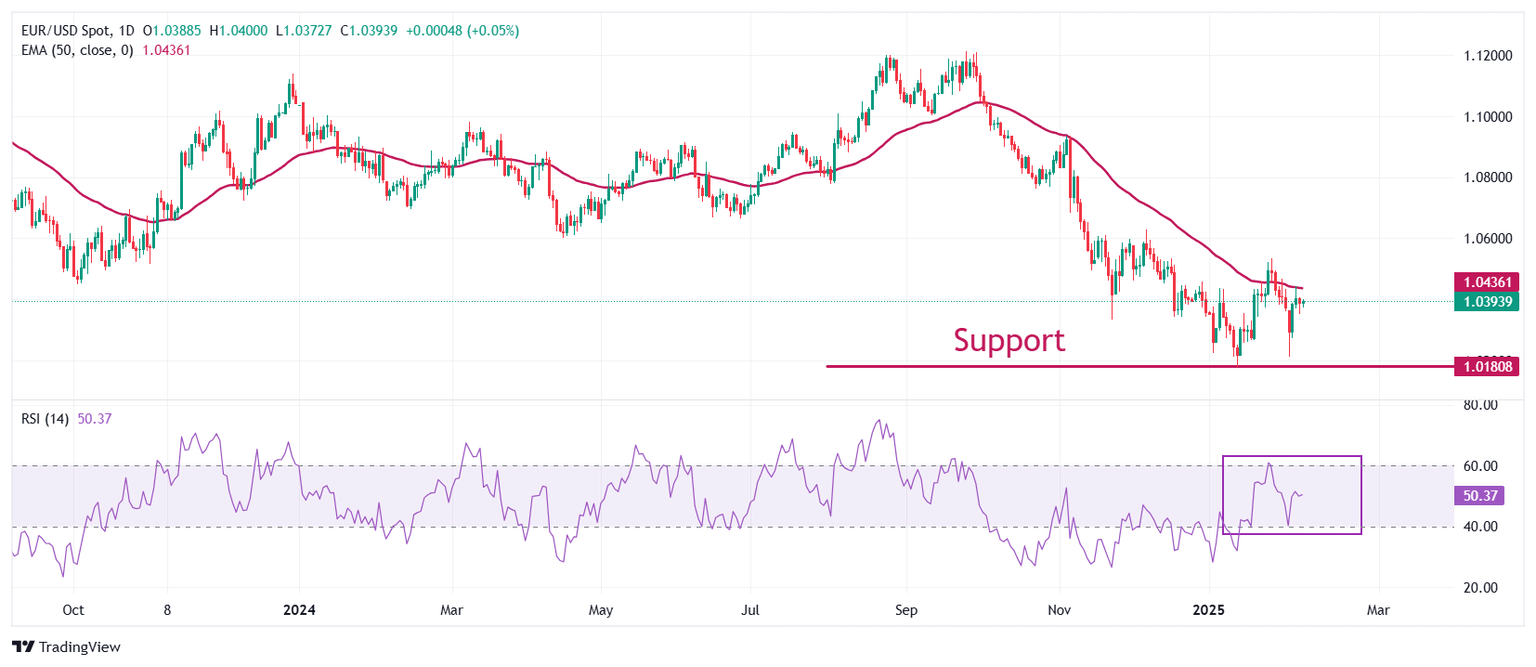EUR/USD weakens as US wage growth heats up
- EUR/USD drops to near 1.0360 after the release of the US NFP data for January.
- The Fed is expected to cut interest rates in the June policy meeting.
- ECB’s Cipollone expects the impact of tariffs on China to be deflationary for the Eurozone.

EUR/USD slides to near 1.0360 in Friday’s North American session as the US Dollar (USD) gains after the release of the United States (US) Nonfarm Payrolls (NFP) data for January. The US Dollar Index (DXY), which tracks the Greenback’s value against six major currencies, gains to near 107.90. The US NFP report showed that the labor demand remained modest, while Average Hourly Earnings heated.
In January, the economy added 143K workers, fewer than estimates of 170K and 307K in December, upwardly revised from 256K. The Unemployment Rate decelerated to 4%, while it was expected to remain steady at 4.1%. Average Hourly Earnings data, a key measure of wage growth that drives consumer spending unexpectedly accelerated to 4.1% year-on-year from 3.9% in December. Economists expected the wage growth measure to have grown at a slower pace of 3.8%. On month, Average Hourly Earnings rose at a faster pace of 0.5%, compared to expectations and the former release of 0.3%.
It would be difficult for market participants to ascertain the impact of the US NFP report on market expectations for the Federal Reserve's monetary policy outlook.
Last week, Fed Chair Jerome Powell said the central bank would make monetary policy adjustments only after seeing “real progress in inflation or at least some weakness in labor market” after the Fed left interest rates unchanged in the range of 4.25%-4.50%.
Daily digest market movers: EUR/USD drops as ECB dovish bets remain firm
- EUR/USD faces selling pressure near 1.0400 as the outlook for the Euro (EUR) remains uncertain amid concerns that the Eurozone is likely to feel the pain of higher tariffs by US President Donald Trump. Last weekend, President Trump warned that Europe will definitely face tariffs for not buying enough American goods, but didn’t provide much information.
- Analysts at Macquarie said President Trump held back specific tariff threats on the Eurozone because of "the lack of a stable government in Germany and France.” Still, they warned that a US tariff bomb would likely find “fertile ground in the EU” and escalate unresolved issues rapidly into trade tensions, given that “Europe is target-rich”.
- In addition to global issues, the Eurozone outlook is also vulnerable because of domestic concerns. Growing risks of economic uncertainty have forced European Central Bank (ECB) officials to guide a dovish monetary policy outlook. ECB’s executive board member Piero Cipollone said in an interview with Reuters on Thursday that all officials agree “there is still room for adjusting rates downwards”.
- When asked about the impact of President Trump’s tariffs on the Eurozone, Cipollone said, “If tariffs are imposed on us, the most immediate impact will be on growth”. He also added that tariffs on China would compel it to look to the shared bloc for dumping its goods due to tariffs from the US. Such a scenario will be deflationary for the economy.
Technical Analysis: EUR/USD remains below 50-day EMA
EUR/USD falls slightly to near 1.0370 in North American trading hours on Friday ahead of the US NFP employment data. The major currency pair faces pressure near the 50-day Exponential Moving Average (EMA) around 1.0436, suggesting that the overall trend is still bearish.
The 14-day Relative Strength Index (RSI) oscillates in the 40.00-60.00 range, indicating a sideways trend.
Looking down, the January 13 low of 1.0177 and the round-level support of 1.0100 will act as major support zones for the pair. Conversely, the psychological resistance of 1.0500 will be the key barrier for the Euro bulls.
Economic Indicator
Average Hourly Earnings (YoY)
The Average Hourly Earnings gauge, released by the US Bureau of Labor Statistics, is a significant indicator of labor cost inflation and of the tightness of labor markets. The Federal Reserve Board pays close attention to it when setting interest rates. A high reading is seen as bullish for the US Dollar (USD), while a low reading is seen as bearish.
Read more.Last release: Fri Feb 07, 2025 13:30
Frequency: Monthly
Actual: 4.1%
Consensus: 3.8%
Previous: 3.9%
Source: US Bureau of Labor Statistics
Author

Sagar Dua
FXStreet
Sagar Dua is associated with the financial markets from his college days. Along with pursuing post-graduation in Commerce in 2014, he started his markets training with chart analysis.


















